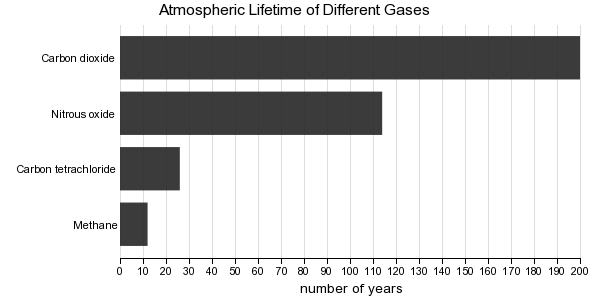This chart shows atmospheric lifetime of different greenhouse gases.
What is atmospheric lifetime?
The lifetime of a greenhouse gas refers to the approximate amount of time it would take for the anthropogenic increment to an atmospheric pollutant concentration to return to its natural level as a result of either being converted to another chemical compound or being taken out of the atmosphere via a sink. This time depends on the pollutant's sources and sinks as well as its reactivity. The lifetime of a pollutant is often considered in conjunction with the mixing of pollutants in the atmosphere; a long lifetime will allow the pollutant to mix throughout the atmosphere. Average lifetimes can vary from about a week (sulfate aerosols) to more than a century (carbon dioxide).
Greenhouse Gases
Human activities result in emissions of four principal greenhouse gases: carbon dioxide (CO2), methane (CH4), nitrous oxide (N2O) and the halocarbons (a group of gases containing fluorine, chlorine and bromine). These gases accumulate in the atmosphere, causing concentrations to increase with time. Significant increases in all of these gases have occurred in the industrial era. All of these increases are attributable to human activities.
- Carbon dioxide has increased from fossil fuel use in transportation, building heating and cooling and the manufacture of cement and other goods. Deforestation releases CO2 and reduces its uptake by plants. Carbon dioxide is also released in natural processes such as the decay of plant matter.
- Methane has increased as a result of human activities related to agriculture, natural gas distribution and landfi lls. Methane is also released from natural processes that occur, for example, in wetlands. Methane concentrations are not currently increasing in the atmosphere because growth rates decreased over the last two decades.
- Nitrous oxide is also emitted by human activities such as fertilizer use and fossil fuel burning. Natural processes in soils and the oceans also release N2O.
Note: water vapor, which has a residence time of about nine days, major greenhouse gases are well-mixed, and take many years to leave the atmosphere. Although it is not easy to know with precision how long it takes greenhouse gases to leave the atmosphere. This is an estimate for the principal greenhouse gases.
14 years ago

